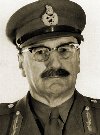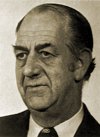Melbourne Tram Museum
- Follow Melbourne Tram Museum on Twitter
- Follow Melbourne Tram Museum on Facebook
- Follow Melbourne Tram Museum on Instagram
- Follow Melbourne Tram Museum on Pinterest
- Follow Melbourne Tram Museum on Tumblr
- Subscribe to Melbourne Tram Museum's RSS feed
- Email Melbourne Tram Museum
Fares please! An economic history of the Melbourne & Metropolitan Tramways Board
Assessment of leadership
Each Chairman of the M&MTB had an impact on its development and direction. It is interesting to compare and contrast the influence that each man exerted on the status of the organisation, particularly from a financial perspective. It should be realised that each of them faced very different environments and challenges, but no matter how able or successful the chairman was in meeting those challenges, the ultimate criteria for any business is its financial performance.
The first Chairman, Alex Cameron, presided over the massive expansion of the electric tramway system, which he pursued with great energy, a quality also displayed in his tenure as Chairman of the Prahran & Malvern Tramways Trust through almost its entire existence.
 Alex Cameron, M&MTB Chairman 1919-1935.
Alex Cameron, M&MTB Chairman 1919-1935. - Official M&MTB photograph.
Cameron clearly demonstrated great leadership and management capability, resolving the many challenges of creating the electric tramway system that would serve Melbourne so well. He established a vertically integrated organisation that undertook everything from rolling stock construction and maintenance, to tramway construction, to the real reason for the Board’s existence – tramway operation.
However, Cameron was not only a good manager – he was also astute at managing the financial position of the M&MTB. This was shown by the deferral of cable tram conversion work during 1928 and between 1930 to 1934. This assessment may be belied by the relatively few surpluses achieved during his reign at the helm, but it was really not in the interest of the M&MTB to generate surpluses at all. The reason for this is that under the Board’s Act it was obliged to distribute large surpluses to the municipalities in which it operated, unless the Board could obtain the agreement of the Minister to retain these surpluses.
Therefore, apart from the first four years of operation, Cameron ensured that the Board ran either small deficits or surpluses, and maximised the investment into the Board’s infrastructure, ensuring the development of a first-class tramway system. As such, he was the most effective of all the M&MTB’s Chairmen.
Hector H. Bell, his successor, also had an extensive experience with the tramways industry, having been on the Board since its inception, and having also been on the Board of the Hawthorn Tramways Trust from its beginning until its takeover by the M&MTB.
 H.H. Bell, M&MTB Chairman 1935-1949.
H.H. Bell, M&MTB Chairman 1935-1949. - Official M&MTB photograph.
The Great Depression had left its mark on Bell. His major concern was to reduce the Board’s indebtedness, whilst continuing to develop the system. This was seen throughout his time in office – one of his last major decisions was to make a massive loan payment in 1949 to reduce the ongoing interest bill. Despite the general improvement of the economy after 1935, the breakneck expansion seen in the previous decade was not resumed. Even the resumption of cable conversion from 1935 was funded out of income rather than borrowings, displaying his innate financial conservatism.
This emphasis on reducing cost drove his decision to convert lightly trafficked cable tram routes to motor omnibus operation, as well as pioneering new bus routes for developmental purposes. Heavily patronised routes were still converted to electric traction, until Bell took a major risk with the decision to change the Bourke Street lines to bus operation. This risk was offset on the basis that if it proved to be unsuccessful, the buses could be used on new routes and the conversion of the Bourke Street lines to electric traction could proceed.
Unfortunately for Bell, he got this one wrong, and Melbourne would suffer with inadequate bus services on Bourke Street for sixteen years. However, Bell did manage the tramways through the tough war years, and enjoyed the best patronage figures throughout the entire history of the M&MTB. In summary, he provided effective and conservative management for the M&MTB, with only one major miscalculation during his time in office.
The challenge that faced the third chairman, Major-General Sir Robert J.H. Risson, was quite different to those faced by his predecessors. The proliferation of private cars cut heavily into patronage, reducing the Board’s income. The booming post-war economy raised worker expectations, so he faced an increasing wages bill and increased costs of materials.
 Major-General Sir RJH Risson, M&MTB Chairman 1949-1970.
Major-General Sir RJH Risson, M&MTB Chairman 1949-1970. - Photograph courtesy the Australian Army.
Fare increases were under the control of the politicians, who were not inclined to make electorally unpopular decisions. Therefore, fares did not offset the reduction in clientele and increase in costs. Also, payments to Consolidated Revenue continued to be a burden on the Board’s revenue stream. Risson worked to remove this obligation, and by 1954 was ultimately successful. He also fought to be relieved of the obligation to fund concession fares, a Government social welfare program which he believed should be funded by Treasury rather than the tramways. He was partially successful in this objective by obtaining an annual operating subsidy from 1958-59.
The only way to improve the financial position was to increase productivity, given that most costs were associated with staffing. The best way to achieve this was the introduction of single man vehicle crews on both buses and trams, which would have resulted in the reduction of about 30% of the Board’s cost base.
Risson took appropriate action by attempting to introduce single man crews on the Board’s buses, but here he showed his great failing as a manager and leader. His military background made it impossible for him to negotiate effectively with the militant unions of the time, and when coupled with the nature of industrial legislation at that time he was doomed to failure, and he suffered continual industrial disputes over this issue.
This meant that basic productivity during the Risson era was not really different from that achieved in the 1920s. Where possible, Risson made significant cost savings, and managed his costs very closely, but this did not substantially alter the situation he faced. Therefore in order to keep the trams running, he had to resort to deficit funding of normal operations, and so throughout his regime, total indebtedness slowly but surely approached the gross capital value of the undertaking.
Although from most aspects an exemplary manager and leader of men, from an economic perspective his time as Chairman was ultimately unsuccessful, due to both external political and legal factors and his authoritarian leadership style. This latter point was also the most likely cause of his failure to develop a suitable successor, as it did not encourage the development of strong subordinate leaders. When viewed in totality, Risson can be considered a great yet flawed Chairman.
This should not belittle his ultimate legacy, which was to ensure the retention of the Melbourne tramway system during an era that saw the closure of most urban tramways across the English speaking world. Melbourne today, at the beginning of the 21st century, benefits from his actions, as trams are now an integral part of the social fabric and global identity of the city. It is now impossible to imagine Melbourne without its tramway system.
 F.R. Kirby, M&MTB Chairman 1970-1976.
F.R. Kirby, M&MTB Chairman 1970-1976. - Official M&MTB photograph.
Francis Kirby, the penultimate Chairman of the M&MTB, was totally ineffectual in his role. He did not keep costs under control, and undertook no new initiatives to improve the M&MTB’s parlous financial status or improve its patronage. The State Government, which had to bail out the Board with ever-increasing subsidies, made all key decisions regarding the system, including the acquisition of new trams and buses.
His weakness as a leader in surrendering control to the Government made life extremely difficult for the final Chairman, F. D. Snell. His ability to make a difference was heavily limited, although he showed signs of some innovation with regard to ticketing, and the involvement of the tramways in the ultimately successful bid for construction of Hong Kong’s Tuen Mun Light Rail Transit system. These initiatives did improve the financial situation slightly, but not enough to make a significant difference.
 Dudley Snell, M&MTB Chairman 1976-1983.
Dudley Snell, M&MTB Chairman 1976-1983. - Official M&MTB photograph.
Effectively, Snell’s ability to influence the financial position of the M&MTB was so constrained he could not make any real impression, so with regard to financial outcomes he has to be judged almost as harshly as Kirby.
So if we assess the five Chairmen of the M&MTB purely on economic criteria, clearly Cameron was the most effective, followed by Bell. While Risson was pivotal in ensuring the survival of Melbourne’s tramway system, from a financial perspective he must be viewed as unsuccessful. Snell was constrained by political control and the financial mess left by Kirby from achieving anything significant, whilst the M&MTB must be considered lucky to have survived Kirby.
So from the perspective of who was the best leader of the M&MTB, the answer must be Cameron, the first and best Chairman: the man who built a world class electric tramways system for Melbourne.